Provenance of Bengal Shelf Sediments: 1. Mineralogy and Geochemistry of Silt
Abstract
:“Vast bamboo jungles towered over the river’s majestic banks, covering those muddy lowlands known to the world as the Sundarbans of the Ganges.”Emilio Salgari, The Two Tigers, Chapter 1.
1. Introduction
2. The Bengal Sediment System
2.1. Mineralogy of River Silt
2.2. Geochemistry of River Silt
2.3. Clay Minerals
3. Analytical Methods
3.1. Sieving of Cohesive Mud
3.2. Optical Microscopy and Raman Spectroscopy
3.3. Bulk Geochemistry
3.4. XRD and XRF Analyses
4. Data
4.1. Grain Size
4.2. Fossil Faunas
4.3. Bulk-Sample Mineralogy
4.4. Heavy Minerals
4.5. Intra-Sample Mineralogical Variability
4.6. Geochemistry
5. Methodological Issues
5.1. Quality Check of Sieving Results
5.2. Mineralogical Analysis of Cohesive Mud
6. Provenance
6.1. Provenance of Silt
6.2. Provenance of Clay Minerals
7. Conclusions
Supplementary Materials
Author Contributions
Acknowledgments
Conflicts of Interest
References
- Blatt, H.; Jones, R.L. Proportions of exposed igneous, metamorphic, and sedimentary rocks. Geol. Soc. Am. Bull. 1975, 86, 1085–1088. [Google Scholar] [CrossRef]
- Pettijohn, F.J. Sedimentary Rocks; Harper & Row: New York, NY, USA, 1975; 776p. [Google Scholar]
- Garrels, R.M. Sediments cycling and diagenesis. Geol. Surv. Bull. 1986, 1578, 1–11. [Google Scholar]
- Potter, P.E.; Maynard, J.B.; Depetris, P.J. Mud and Mudstones: Introduction and Overview; Springer Science & Business Media: Berlin, Germany, 2005; 297p. [Google Scholar]
- Andò, S.; Aharonovich, S.; Hahn, A.; George, S.C.; Clift, P.D.; Garzanti, E. Integrating heavy-mineral, geochemical, and biomarker analyses of Plio-Pleistocene sandy and silty turbidites: A novel approach for provenance studies (Indus Fan, IODP Expedition 355). Geol. Mag. 2019. [Google Scholar] [CrossRef]
- Caracciolo, L.; Andò, S.; Vermeesch, P.; Garzanti, E.; McCabe, R.; Barbarano, M.; Paleari, C.; Rittner, M.; Pearce, T. A multidisciplinary approach for the quantitative provenance analysis of siltstone. Mesozoic Mandawa Basin, southeastern Tanzania. Geol. Soc. Lond. Spec. Publ. 2019, 484. [Google Scholar] [CrossRef]
- Kudrass, H.R.; Spiess, V.; Bruns, A.; Ding, F.; Fekete, N.; Fenner, J.; France-Lanord, C.; Palamenghi, L.; Reinhardt, L.; Rühlemann, C.; et al. Cruise Report SO 188-2 Chittagong (Bangladesh)—Penang (Malaysia) 06.07.2006—31.07.2006; BGR: Hannover, Germany, 2007; pp. 1–100. [Google Scholar]
- Garzanti, E.; Andò, S.; France-Lanord, C.; Limonta, M.; Borromeo, L.; Vezzoli, G. Provenance of Bengal Shelf Sediments. 2. Petrology and geochemistry of sand. Minerals 2019, in press. [Google Scholar]
- Allison, M.A.; Khan, S.R.; Goodbred, S.L.; Kuehl, S.A. Stratigraphic evolution of the late Holocene Ganges–Brahmaputra lower delta plain. Sediment. Geol. 2003, 155, 317–342. [Google Scholar] [CrossRef]
- Kuehl, S.A.; Allison, M.A.; Goodbred, S.L.; Kudrass, H. The Ganges-Brahmaputra Delta. In River Deltas—Concepts, Models, and Examples; Giosan, L., Bhattacharya, J.P., Eds.; Society for Sedimentary Geology (SEPM) Special Publication NO. 83; Society for Sedimentary Geology (SEPM): Tulsa, OK, USA, 2005; pp. 413–434. [Google Scholar]
- Goodbred, S.L.; Kuehl, S.A. Enormous Ganges-Brahmaputra sediment discharge during strengthened early Holocene monsoon. Geology 2000, 28, 1083–1086. [Google Scholar] [CrossRef]
- Curray, J.R.; Emmel, F.J.; Moore, D.G. The Bengal Fan: Morphology, geometry, stratigraphy, history and processes. Mar. Pet. Geol. 2003, 19, 1191–1223. [Google Scholar] [CrossRef]
- Thompson, R.W. Mineralogy of sands from the Bengal and Nicobar fans, Sites 218 and 211, Eastern Indian Ocean. Initial Rep. DSDP 1974, 22, 711–713. [Google Scholar]
- Ingersoll, R.V.; Suczek, C.A. Petrology and provenance of Neogene sand from Nicobar and Bengal Fans, DSDP Sites 211 and 218. J. Sedim. Petrol. 1979, 49, 1217–1228. [Google Scholar]
- Yokoyama, K. Mineralogy of silts from the Bengal Fan. Proc. ODP Sci. Results 1990, 116, 59–73. [Google Scholar]
- France-Lanord, C.; Derry, L.; Michard, A. Evolution of the Himalaya since Miocene time: Isotopic and sedimentological evidence from the Bengal Fan. Geol. Soc. Lond. Spec. Publ. 1993, 74, 603–621. [Google Scholar] [CrossRef]
- Galy, A.; France-Lanord, C.; Derry, L.A. The strontium isotopic budget of Himalayan rivers in Nepal and Bangladesh. Geochim. Cosmochim. Acta 1999, 63, 1905–1925. [Google Scholar] [CrossRef]
- Galy, A.; France-Lanord, C. Higher Erosion rates in the Himalaya: Geochemical constraints on riverine fluxes. Geology 2001, 29, 23–26. [Google Scholar] [CrossRef]
- Galy, V.; France-Lanord, C.; Beyssac, O.; Faure, P.; Kudrass, H.; Palhol, F. Efficient organic carbon burial in the Bengal fan sustained by the Himalayan erosional system. Nature 2007, 450, 407. [Google Scholar] [CrossRef]
- Singh, S.K.; France-Lanord, C. Tracing the distribution of erosion in the Brahmaputra watershed from isotopic compositions of stream sediments. Earth Planet. Sci. Lett. 2002, 202, 645–662. [Google Scholar] [CrossRef]
- Garzanti, E.; Vezzoli, G.; Andò, S.; France-Lanord, C.; Singh, S.K.; Foster, G. Sand petrology and focused erosion in collision orogens: The Brahmaputra case. Earth Planet. Sci. Lett. 2004, 220, 157–174. [Google Scholar] [CrossRef]
- Garzanti, E.; Vezzoli, G.; Andò, S.; Lavé, J.; Attal, M.; France-Lanord, C.; DeCelles, P. Quantifying sand provenance and erosion (Marsyandi River, Nepal Himalaya). Earth Planet. Sci. Lett. 2007, 258, 500–515. [Google Scholar] [CrossRef]
- Garzanti, E.; Andò, S.; France-Lanord, C.; Vezzoli, G.; Censi, P.; Galy, V.; Najman, Y. Mineralogical and chemical variability of fluvial sediments: 1. Bedload sand (Ganga–Brahmaputra, Bangladesh). Earth Planet. Sci. Lett. 2010, 299, 368–381. [Google Scholar] [CrossRef]
- Garzanti, E.; Andò, S.; France-Lanord, C.; Censi, P.; Vignola, P.; Galy, V.; Lupker, M. Mineralogical and chemical variability of fluvial sediments. 2. Suspended-load silt (Ganga-Brahmaputra, Bangladesh). Earth Planet. Sci. Lett. 2011, 302, 107–120. [Google Scholar] [CrossRef]
- Lupker, M.; France-Lanord, C.; Lavé, J.; Bouchez, J.; Galy, V.; Métivier, F.; Gaillardet, J.; Lartiges, B.; Mugnier, J.L. A Rouse-based method to integrate the chemical composition of river sediments: Application to the Ganga basin. J. Geophys. Res. Earth Surf. 2011, 116, 1–24. [Google Scholar] [CrossRef]
- Lupker, M.; France-Lanord, C.; Galy, V.; Lavé, J.; Gaillardet, J.; Gajurel, A.P.; Guilmette, C.; Rahman, M.; Singh, S.K.; Sinha, R. Predominant floodplain over mountain weathering of Himalayan sediments (Ganga basin). Geochim. Cosmochim. Acta 2012, 84, 410–432. [Google Scholar] [CrossRef] [Green Version]
- Lupker, M.; France-Lanord, C.; Galy, V.; Lavé, J.; Kudrass, H. Increasing chemical weathering in the Himalayan system since the Last Glacial Maximum. Earth Planet. Sci. Lett. 2013, 365, 243–252. [Google Scholar] [CrossRef] [Green Version]
- Weltje, G.J. A quantitative approach to capturing the compositional variability of modern sands. Sediment. Geol. 2004, 171, 59–77. [Google Scholar] [CrossRef]
- Garzanti, E.; Andò, S.; Vezzoli, G. Grain-size dependence of sediment composition and environmental bias in provenance studies. Earth Planet. Sci. Lett. 2009, 277, 422–432. [Google Scholar] [CrossRef]
- Garzanti, E. Stratigraphy and sedimentary history of the Nepal Tethys Himalayan passive margin. J. Asian Earth Sci. 1999, 17, 805–827. [Google Scholar] [CrossRef]
- Sciunnach, D.; Garzanti, E. Subsidence history of the Tethys Himalaya. Earth Sci. Rev. 2012, 25, 179–198. [Google Scholar] [CrossRef]
- Colchen, M.; Le Fort, P.; Pêcher, A. Annapurna, Manaslu, Ganesh Himal; Editions du Centre National de la Recherche Scientifique: Paris, France, 1986; 136p. [Google Scholar]
- Carosi, R.; Montomoli, C.; Iaccarino, S. 20 years of geological mapping of the metamorphic core across Central and Eastern Himalayas. Earth Sci. Rev. 2017, 177, 124–138. [Google Scholar] [CrossRef]
- Sakai, H. Rifting of the Gondwanaland and uplifting of the Himalayas recorded in Mesozoic and Tertiary fluvial sediments in the Nepal Himalayas. In Sedimentary Facies in the Active Plate Margin; Taira, A., Masuda, F., Eds.; Terra Scientific Publications: Tokyo, Japan, 1989; pp. 723–732. [Google Scholar]
- DeCelles, P.G.; Robinson, D.M.; Quade, J.; Ojha, T.P.; Garzione, C.N.; Copeland, P.; Upreti, B.N. Stratigraphy, structure, and tectonic evolution of the Himalayan fold-thrust belt in western Nepal. Tectonics 2001, 20, 487–509. [Google Scholar] [CrossRef]
- DeCelles, P.G.; Gehrels, G.E.; Quade, J.; Ojha, T.P.; Kapp, P.A.; Upreti, B.N. Neogene foreland basin deposits, erosional unroofing, and the kinematic history of the Himalayan fold-thrust belt, western Nepal Siwaliks. Geol. Soc. Am. Bull. 1998, 110, 2–21. [Google Scholar] [CrossRef]
- Garzanti, E. The Himalayan foreland basin from collision onset to the present: A sedimentary-petrology perspective. In Himalayan Tectonics: A Modern Synthesis; Treloar, P., Searle, M.P., Eds.; Special Publication 483; Geological Society: London, UK, 2019; pp. 65–122. [Google Scholar] [CrossRef]
- Zhu, D.C.; Zhao, Z.D.; Niu, Y.L.; Mo, X.X.; Chung, S.L.; Hou, Z.Q.; Wang, L.Q.; Wu, F.Y. The Lhasa terrane: Record of a microcontinent and its histories of drift and growth. Earth Planet. Sci. Lett. 2011, 301, 241–255. [Google Scholar] [CrossRef]
- Wang, J.-G.; Hu, X.M.; Garzanti, E.; An, W.; Liu, X.-C. The birth of the Xigaze forearc basin in southern Tibet. Earth Planet. Sci. Lett. 2017, 465, 38–47. [Google Scholar] [CrossRef] [Green Version]
- Hébert, R.; Bezard, R.; Guilmette, C.; Dostal, J.; Wang, C.S.; Liu, Z.F. The Indus–Yarlung Zangbo ophiolites from Nanga Parbat to Namche Barwa syntaxes, southern Tibet: First synthesis of petrology, geochemistry, and geochronology with incidences on geodynamic reconstructions of Neo-Tethys. Gondwana Res. 2012, 22, 377–397. [Google Scholar] [CrossRef]
- Burg, J.P.; Nievergelt, P.; Oberli, F.; Seward, D.; Davy, P.; Maurin, J.C.; Diao, Z.; Meier, M. The Namche Barwa syntaxis: Evidence for exhumation related to compressional crustal folding. J. Asian Earth Sci. 1998, 16, 239–252. [Google Scholar] [CrossRef]
- Goodbred, S.L.; Paolo, P.M.; Ullah, M.S.; Pate, R.D.; Khan, S.R.; Kuehl, S.A.; Singh, S.K.; Rahaman, W. Piecing together the Ganges-Brahmaputra-Meghna River delta: Use of sediment provenance to reconstruct the history and interaction of multiple fluvial systems during Holocene delta evolution. Geol. Soc. Am. Bull. 2014, 126, 1495–1510. [Google Scholar] [CrossRef]
- Delft Hydraulics. River Survey Project, Flood Action Plan 24, Special Report NO. 18. In Sediment Rating Curves and Balances; Water Resources Planning Organization: Dhaka, Bangladesh, 1996. [Google Scholar]
- France-Lanord, C.; Spiess, V.; Klaus, A.; Schwenk, T.; Adhikari, T.T.; Adhikari, S.K.; Bahk, J.J.; Baxter, A.T.; Cruz, J.W.; Das, S.K.; et al. Expedition 354 summary. In International Ocean Discovery Program 354 Preliminary Report; IODP: College Station, TX, USA, 2016; pp. 1–35. [Google Scholar]
- Sinha, R.; Friend, P.F. River systems and their sediment flux, Indo-Gangetic Plains, northern Bihar, India. Sedimentology 1994, 41, 825–845. [Google Scholar] [CrossRef]
- Milliman, J.D.; Syvitski, J.P. Geomorphic/tectonic control of sediment discharge to the ocean: The importance of small mountainous rivers. J. Geol. 1992, 100, 525–544. [Google Scholar] [CrossRef]
- Summerfield, M.A.; Hulton, N.J. Natural controls of fluvial denudation rates in major world drainage basins. J. Geophys. Res. 1994, 99, 13871–13883. [Google Scholar] [CrossRef]
- Goodbred, S.L.; Kuehl, S.A. Holocene and modern sediment budgets for the Ganga-Brahmaputra river system: Evidence for highstand dispersal to flood-plain, shelf, and deep-sea depocenters. Geology 1999, 27, 559–562. [Google Scholar] [CrossRef]
- Milliman, J.D.; Meade, R.H. World delivery of river sediment to the oceans. J. Geol. 1983, 91, 1–21. [Google Scholar] [CrossRef]
- Singh, I.B. The Ganga River. In Large Rivers: Geomorphology and Management; Gupta, A., Ed.; Wiley: New York, NY, USA, 2007; pp. 347–371. [Google Scholar]
- Hübscher, C.; Spiess, V. Forced regression systems tracts on the Bengal Shelf. Mar. Geol. 2005, 219, 207–218. [Google Scholar] [CrossRef]
- Palamenghi, L.; Schwenk, T.; Spiess, V.; Kudrass, H.R. Seismostratigraphic analysis with centennial to decadal time resolution of the sediment sink in the Ganges–Brahmaputra subaqueous delta. Cont. Shelf Res. 2011, 31, 712–730. [Google Scholar] [CrossRef]
- Kudrass, H.R.; Machalett, B.; Palamenghi, L.; Meyer, I.; Zhang, W. Sediment transport by tropical cyclones recorded in a submarine canyon off Bangladesh. Geo Mar. Lett. 2018, 38, 481–496. [Google Scholar] [CrossRef]
- Singh, S.K.; Sarin, M.M.; France-Lanord, C. Chemical erosion in the eastern Himalaya: Major ion composition of the Brahmaputra and δ13C of dissolved inorganic carbon. Geochim. Cosmochim. Acta 2005, 69, 3573–3588. [Google Scholar] [CrossRef]
- Garçon, M.; Chauvel, C. Where is basalt in river sediments, and why does it matter? Earth Planet. Sci. Lett. 2014, 407, 61–69. [Google Scholar] [CrossRef]
- Sarin, M.M.; Krishnaswami, S.; Dilli, K.; Somayajulu, B.L.K.; Moore, W.S. Major ion chemistry of the Ganga-Brahmaputra river system: Weathering processes and fluxes to the Bay of Bengal. Geochim. Cosmochim. Acta 1989, 53, 997–1009. [Google Scholar] [CrossRef]
- Datta, D.K.; Subramanian, V. Texture and mineralogy of sediments from the Ganges-Brahmaputra-Meghna river system in the Bengal Basin, Bangladesh and their environmental implications. Environ. Geol. 1997, 30, 181–188. [Google Scholar] [CrossRef]
- Heroy, D.C.; Kuehl, S.A.; Goodbred, S.L. Mineralogy of the Ganges and Brahmaputra Rivers: Implications for river switching and Late Quaternary climate change. Sediment. Geol. 2003, 155, 343–359. [Google Scholar] [CrossRef]
- Huyghe, P.; Guilbaud, R.; Bernet, M.; Galy, A.; Gajurel, A.P. Significance of the clay mineral distribution in fluvial sediments of the Neogene to recent Himalayan foreland basin (west-central Nepal). Basin Res. 2011, 23, 332–345. [Google Scholar] [CrossRef]
- Khan, M.H.R.; Liu, J.; Liu, S.; Seddique, A.A.; Cao, L.; Rahman, A. Clay mineral compositions in surface sediments of the Ganges-Brahmaputra-Meghna river system of Bengal Basin, Bangladesh. Mar. Geol. 2019, 412, 27–36. [Google Scholar] [CrossRef]
- Segall, M.P.; Kuehl, S.A. Sedimentary processes on the Bengal continental shelf as revealed by clay-size mineralogy. Cont. Shelf Res. 1992, 12, 517–541. [Google Scholar] [CrossRef]
- Andò, S.; Vignola, P.; Garzanti, E. Raman counting: A new method to determine provenance of silt. Rend. Lincei 2011, 22, 327–347. [Google Scholar] [CrossRef]
- Mange, M.A.; Maurer, H.F.W. Heavy Minerals in Colour; Chapman and Hall: London, UK, 1992; p. 147. [Google Scholar]
- Andò, S.; Garzanti, E. Raman spectroscopy in heavy-mineral studies. Geol. Soc. Lond. Spec. Publ. 2014, 386, 395–412. [Google Scholar] [CrossRef]
- Lünsdorf, N.K.; Kalies, J.; Ahlers, P.; Dunkl, I.; von Eynatten, H. Semi-Automated Heavy-Mineral Analysis by Raman Spectroscopy. Minerals 2019, 9, 385. [Google Scholar] [CrossRef]
- Andò, S. Gravimetric separation of heavy-minerals in sediments. Minerals 2019. in preparation. [Google Scholar]
- Garzanti, E.; Andò, S. Heavy Minerals for Junior Woodchucks. Minerals 2019, 9, 148. [Google Scholar] [CrossRef]
- Garzanti, E.; Andò, S. Heavy-mineral concentration in modern sands: Implications for provenance interpretation. In Heavy Minerals in Use; Mange, M.A., Wright, D.T., Eds.; Developments in Sedimentology Series 58; Elsevier: Amsterdam, The Netherlands, 2007; pp. 517–545. [Google Scholar]
- Mernagh, T.P. Use of the laser Raman microprobe for discrimination amongst feldspar minerals. J. Raman Spectrosc. 1991, 22, 453–457. [Google Scholar] [CrossRef]
- McKeown, D.A. Raman spectroscopy and vibrational analyses of albite: From 25 °C through the melting temperature. Am. Min. 2005, 90, 1506–1517. [Google Scholar] [CrossRef]
- Freeman, J.J.; Wang, A.; Kuebler, K.E.; Jolliff, B.L.; Haskin, L.A. Characterization of natural feldspars by Raman spectroscopy for future planetary exploration. Canad. Miner. 2008, 46, 1477–1500. [Google Scholar] [CrossRef]
- Bersani, D.; Aliatis, I.; Tribaudino, M.; Mantovani, L.; Benisek, A.; Carpenter, M.A.; Gatta, D.G.; Lottici, P.P. Plagioclase composition by Raman spectroscopy. J Raman Spectrosc. 2018, 49, 684–698. [Google Scholar] [CrossRef]
- Kübler, K.; Wang, A.; Abbott, K.; Haskin, L.A. Can we detect carbonate and sulfate minerals on the surface of Mars by Raman spectroscopy? In Proceedings of the 32th Annual Lunar and Planetary Science Conference, Houston, TX, USA, 12–16 March 2001. [Google Scholar]
- Borromeo, L.; Zimmermann, U.; Andò, S.; Coletti, G.; Bersani, D.; Basso, D.; Gentile, P.; Schulz, B.; Garzanti, E. Raman spectroscopy as a tool for magnesium estimation in Mg-calcite. J Raman Spectrosc. 2017, 48, 983–992. [Google Scholar] [CrossRef]
- Rruff, database of Raman spectroscopy. Available online: www.rruff.info (accessed on 17 October 2019).
- Laboratory of Photoinduced Effects, Vibrational and X-Ray Spectroscopies, University of Parma. Available online: www.fis.unipr.it/phevix/ramandb.php (accessed on 17 October 2019).
- Raman Open Database. Available online: www.solsa.crystallography.net/rod/index.php (accessed on 17 October 2019).
- Huang, E.; Chen, C.H.; Huang, T.; Lin, E.H.; Xu, J.A. Raman spectroscopic characteristics of Mg-Fe-Ca pyroxenes. Am. Mineral. 2000, 85, 473–479. [Google Scholar] [CrossRef]
- Bersani, D.; Andò, S.; Vignola, P.; Moltifiori, G.; Marino, I.G.; Lottici, P.P.; Diella, V. Micro-Raman spectroscopy as a routine tool for garnet analysis. Spectrochim. Acta Part A Mol. Biomol. Spectrosc. 2009, 73, 484–491. [Google Scholar] [CrossRef] [PubMed]
- Govindaraju, K.; Mevelle, G. Fully automated dissolution and separation methods for inductively coupled plasma atomic emission spectrometry rock analysis. Application to the determination of rare earth elements. Plenary lecture. J. Anal. At. Spectrom. 1987, 2, 615–621. [Google Scholar] [CrossRef]
- Carignan, J.; Hild, P.; Mevelle, G.; Morel, J.; Yeghicheyan, D. Routine analyses of trace elements in geological samples using flow injection and low pressure on-line liquid chromatography coupled to ICP-MS: A study of geochemical reference materials BR, DR-N, UB-N, AN-G and GH. Geostand. Newsl. 2001, 25, 187–198. [Google Scholar] [CrossRef]
- Köhn, M. Bemerkungen zur mechanischen Bodenanalyse. III. Ein neuer Pipettapparat. Z. Für Pflanz. DüngungBodenkd. 1928, 11, 50–54. [Google Scholar] [CrossRef]
- Govin, A.; Holzwarth, U.; Heslop, D.; Ford Keeling, L.; Zabel, M.; Mulitza, S.; Collins, J.A.; Chiessi, C.M. Distribution of major elements in Atlantic surface sediments (36° N–49° S): Imprint of terrigenous input and continental weathering. Geochem. Geophys. Geosyst. 2012, 13, Q01013. [Google Scholar] [CrossRef]
- Malvern Panalytical. Available online: www.malvernpanalytical.com (accessed on 17 October 2019).
- MacDiff Software. Available online: www.uni-frankfurt.de/69620898/Petschick (accessed on 17 October 2019).
- Petschick, R.; Kuhn, G.; Gingele, F. Clay mineral distribution in surface sediments of the South Atlantic: Sources, transport, and relation to oceanography. Mar. Geol. 1996, 130, 203–229. [Google Scholar] [CrossRef]
- Vogt, C.; Lauterjung, J.; Fischer, R.X. Investigation of the clay fraction (<2 μm) of the clay mineral society reference clays. Clays Clay Min. 2002, 50, 388–400. [Google Scholar] [CrossRef]
- Roberson, S.; Weltje, G.J. Inter-instrument comparison of particle-size analysers. Sedimentology 2014, 61, 1157–1174. [Google Scholar] [CrossRef]
- Konert, M.; Vandenberghe, J. Comparison of laser grain size analysis with pipette and sieve analysis: A solution for the underestimation of the clay fraction. Sedimentology 1997, 44, 523–535. [Google Scholar] [CrossRef]
- Beuselinck, L.; Govers, G.; Poesen, J.; Degraer, G.; Froyen, L. Grain-size analysis by laser diffractometry: Comparison with the sieve-pipette method. Catena 1998, 32, 193–208. [Google Scholar] [CrossRef]
- Goossens, D. Techniques to measure grain-size distributions of loamy sediments: A comparative study of ten instruments for wet analysis. Sedimentology 2008, 55, 65–96. [Google Scholar] [CrossRef]
- Murray, J.W. Ecology and Palaeoecology of Benthic Foraminifera; Routledge: Abingdon, UK, 2014; 408p. [Google Scholar]
- Palamenghi, L. Tectonic and sea level control on the transport and depositional processes in a siliciclastic sedimentary basin. Insights from the Ganges-Brahmaputra Delta, Bengal Basin, Bangladesh. Ph.D. Thesis, Faculty of Geosciences, University of Bremen, Bremen, Germany, 2012; 147p. [Google Scholar]
- Garzanti, E. Non-carbonate intrabasinal grains in arenites: Their recognition, significance and relationship to eustatic cycles and tectonic setting. J. Sediment. Petrol. 1991, 61, 959–975. [Google Scholar]
- Opdyke, B.N.; Wilkinson, B.H. Paleolatitude distribution of Phanerozoic marine ooids and cements. Palaeogeogr. Palaeoclimatol. Palaeoecol. 1990, 78, 135–148. [Google Scholar] [CrossRef] [Green Version]
- Gallagher, S.J.; Reuning, L.; Himmler, T.; Henderiks, J.; De Vleeschouwer, D.; Groeneveld, J.; Rastegar Lari, A.; Fulthorpe, C.S.; Bogus, K.; et al. The enigma of rare Quaternary oolites in the Indian and Pacific Oceans: A result of global oceanographic physicochemical conditions or a sampling bias? Quat. Sci. Rev. 2018, 200, 114–122. [Google Scholar] [CrossRef]
- Wiedicke, M.; Kudrass, H.R.; Hübscher, C. Oolitic beach barriers of the last Glacial sea-level lowstand at the outer Bengal shelf. Mar. Geol. 1999, 157, 7–18. [Google Scholar] [CrossRef]
- Garzanti, E. Petrographic classification of sand and sandstone. Earth Sci. Rev. 2019, 192, 545–563. [Google Scholar] [CrossRef]
- Garzanti, E.; Andò, S. Plate tectonics and heavy-mineral suites of modern sands. In Heavy Minerals in Use; Mange, M.A., Wright, D.T., Eds.; Developments in Sedimentology Series 58; Elsevier: Amsterdam, The Netherlands, 2007; pp. 741–763. [Google Scholar]
- Andò, S.; Garzanti, E.; Padoan, M.; Limonta, M. Corrosion of heavy minerals during weathering and diagenesis: A catalog for optical analysis. Sediment. Geol. 2012, 280, 165–178. [Google Scholar] [CrossRef]
- Rubey, W.W. The size-distribution of heavy minerals within a water-laid sandstone. J. Sediment. Pet. 1933, 3, 3–29. [Google Scholar]
- Garzanti, E.; Andò, S.; Vezzoli, G. Settling-equivalence of detrital minerals and grain-size dependence of sediment composition. Earth Planet. Sci. Lett. 2008, 273, 138–151. [Google Scholar] [CrossRef]
- Gabriel, K.R. The biplot graphic display of matrices with application to principal component analysis. Biometrika 1971, 58, 453–467. [Google Scholar] [CrossRef]
- Comas-Cufí, M.; Thió-Henestrosa, F.S. CoDaPack 2.0: A Stand-Alone, Multi-Platform Compositional Software. In Proceedings of the 4th International Workshop on Compositional Data Analysis, Girona, Spain, 10–13 May 2011. [Google Scholar]
- Delmonte, B.; Paleari, C.I.; Andò, S.; Garzanti, E.; Andersson, P.S.; Petit, J.R.; Crosta, X.; Narcisi, B.; Baroni, C.; Salvatore, M.C.; et al. Causes of dust size variability in central East Antarctica (Dome B): Atmospheric transport from expanded South American sources during Marine Isotope Stage 2. Quat. Sci. Rev. 2017, 168, 55–68. [Google Scholar] [CrossRef] [Green Version]
- Borromeo, L.; Egeland, N.; Minde, M.W.; Zimmermann, U.; Andò, S.; Madland, M.V.; Korsnes, R.I. Quick, easy, and economic mineralogical studies of flooded chalk for EOR experiments using Raman spectroscopy. Minerals 2018, 8, 221. [Google Scholar] [CrossRef]
- Paleari, C.I.; Delmonte, B.; Andò, S.; Garzanti, E.; Petit, J.R.; Maggi, V. Aeolian dust provenance in central east Antarctica during the Holocene: Environmental constraints from single-grain Raman spectroscopy. Geophys. Res. Lett. 2019, 46, 9968–9979. [Google Scholar] [CrossRef]
- Moore, D.; Reynolds, R. X-Ray-Diffraction and the Identification and Analysis of Clay Minerals; Oxford University Press: New York, NY, USA, 1997. [Google Scholar]
- Galehouse, J.S. Point counting. In Procedures in Sedimentary Petrology; Carver, R.E., Ed.; Wiley: New York, NY, USA, 1971; pp. 385–407. [Google Scholar]
- Flood, R.P.; Barra, I.D.; Weltje, G.J.; Roberson, S.; Russell, M.I.; Meneely, J.; Orford, J.D. Provenance and depositional variability of the Thin Mud Facies in the lower Ganges-Brahmaputra delta, West Bengal Sundarbans, India. Mar. Geol. 2018, 395, 198–218. [Google Scholar] [CrossRef] [Green Version]
- Dickinson, W.R. Interpreting provenance relations from detrital modes of sandstones. In Provenance of Arenites; Zuffa, G.G., Ed.; NATO ASI Series 148; Reidel: Dordrecht, The Netherlands, 1985; pp. 333–361. [Google Scholar]
- Odom, I.E.; Doe, T.W.; Dott, R.H. Nature of feldspar-grain size relations in some quartz-rich sandstones. J. Sediment. Petrol. 1976, 46, 862–870. [Google Scholar]
- Dott, R.H. The importance of eolian abrasion in supermature quartz sandstones and the paradox of weathering on vegetation-free landscapes. J. Geol. 2003, 111, 387–405. [Google Scholar] [CrossRef]
- Garzanti, E.; Resentini, A.; Vezzoli, G.; Andò, S.; Malusà, M.; Padoan, M. Forward compositional modelling of Alpine orogenic sediments. Sediment. Geol. 2012, 280, 149–164. [Google Scholar] [CrossRef]
- Resentini, A.; Goren, L.; Castelltort, S.; Garzanti, E. Partitioning the sediment flux by provenance and tracing erosion patterns in Taiwan. J. Geophys. Res. Earth Surf. 2017, 122. [Google Scholar] [CrossRef]


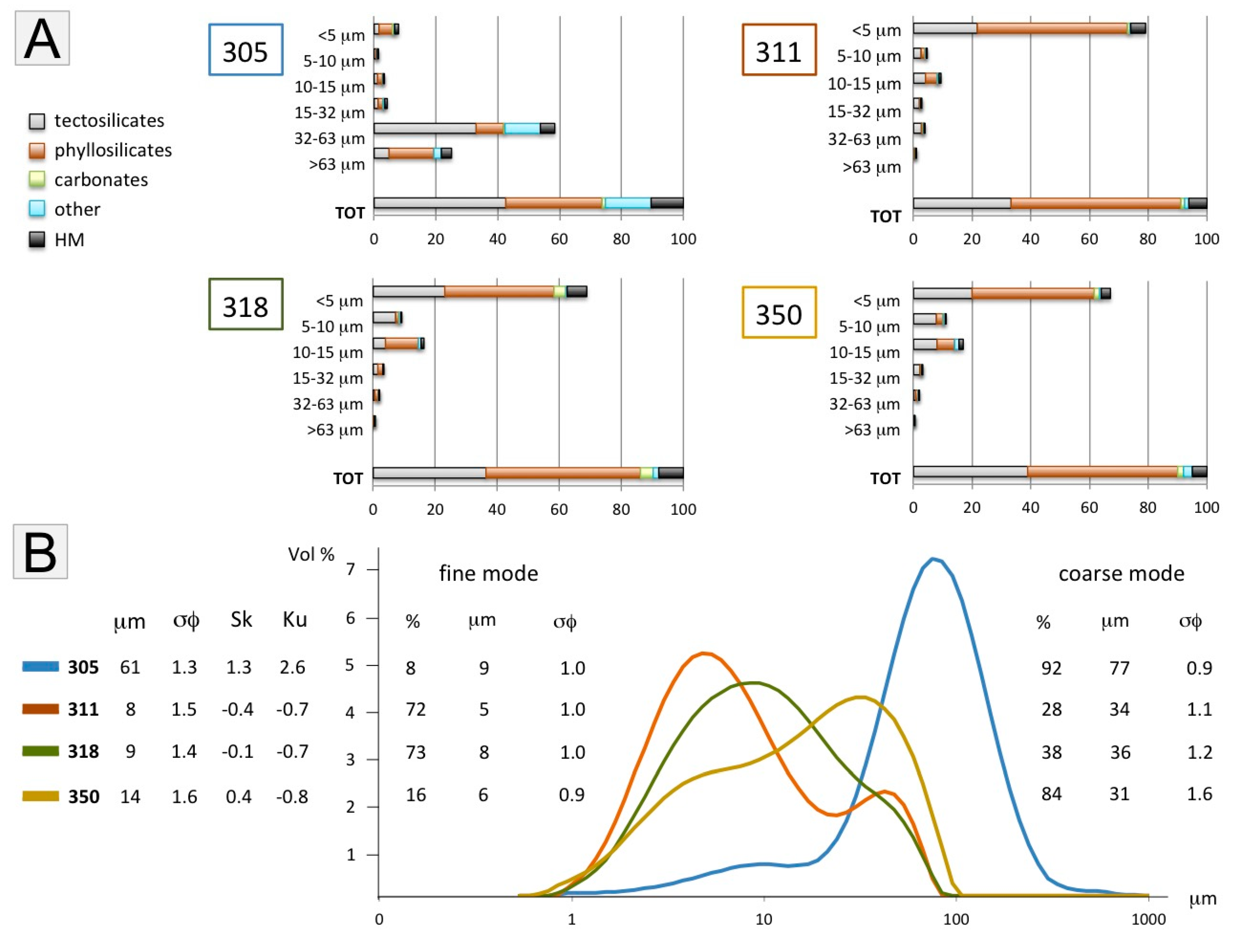

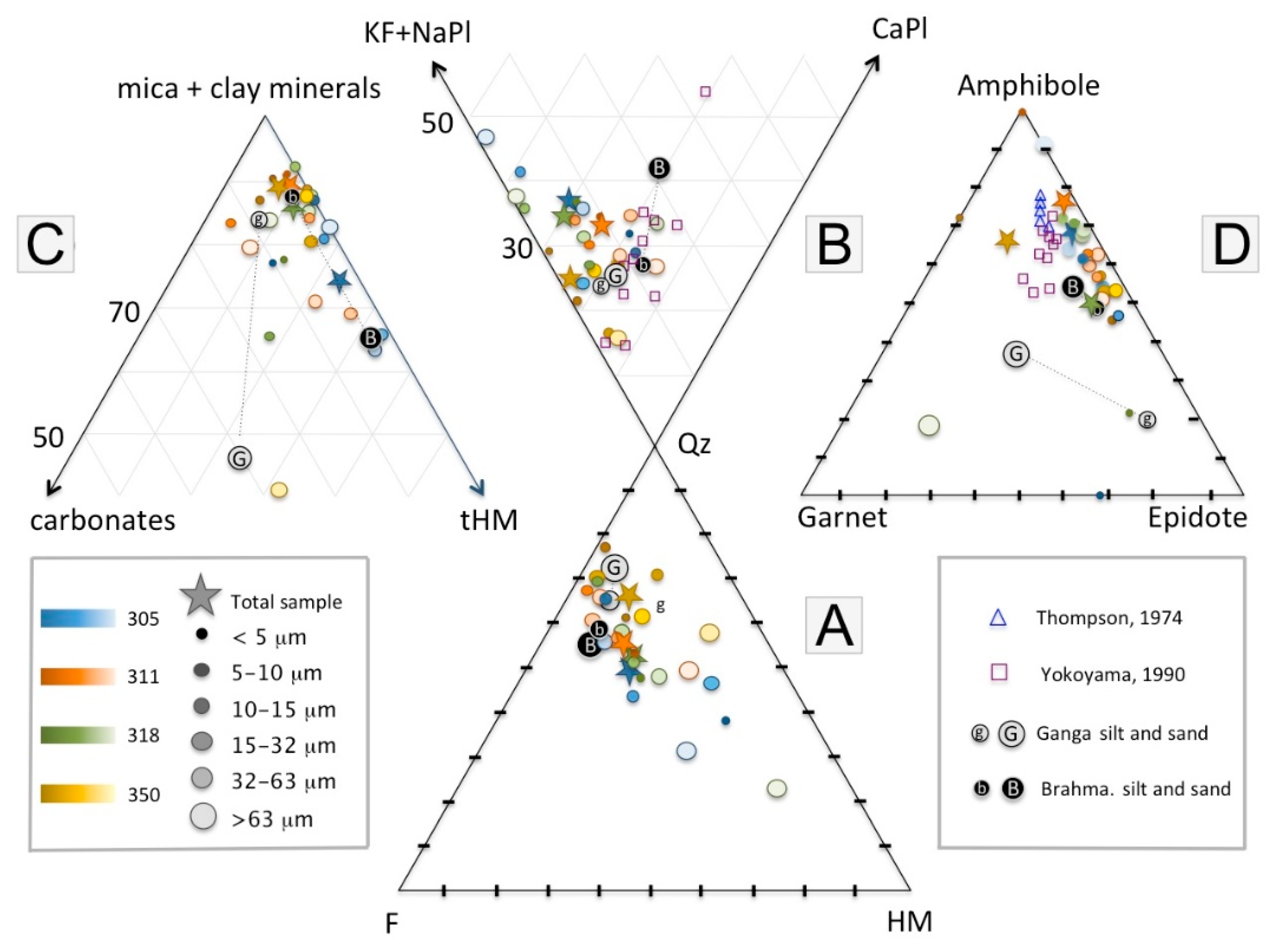
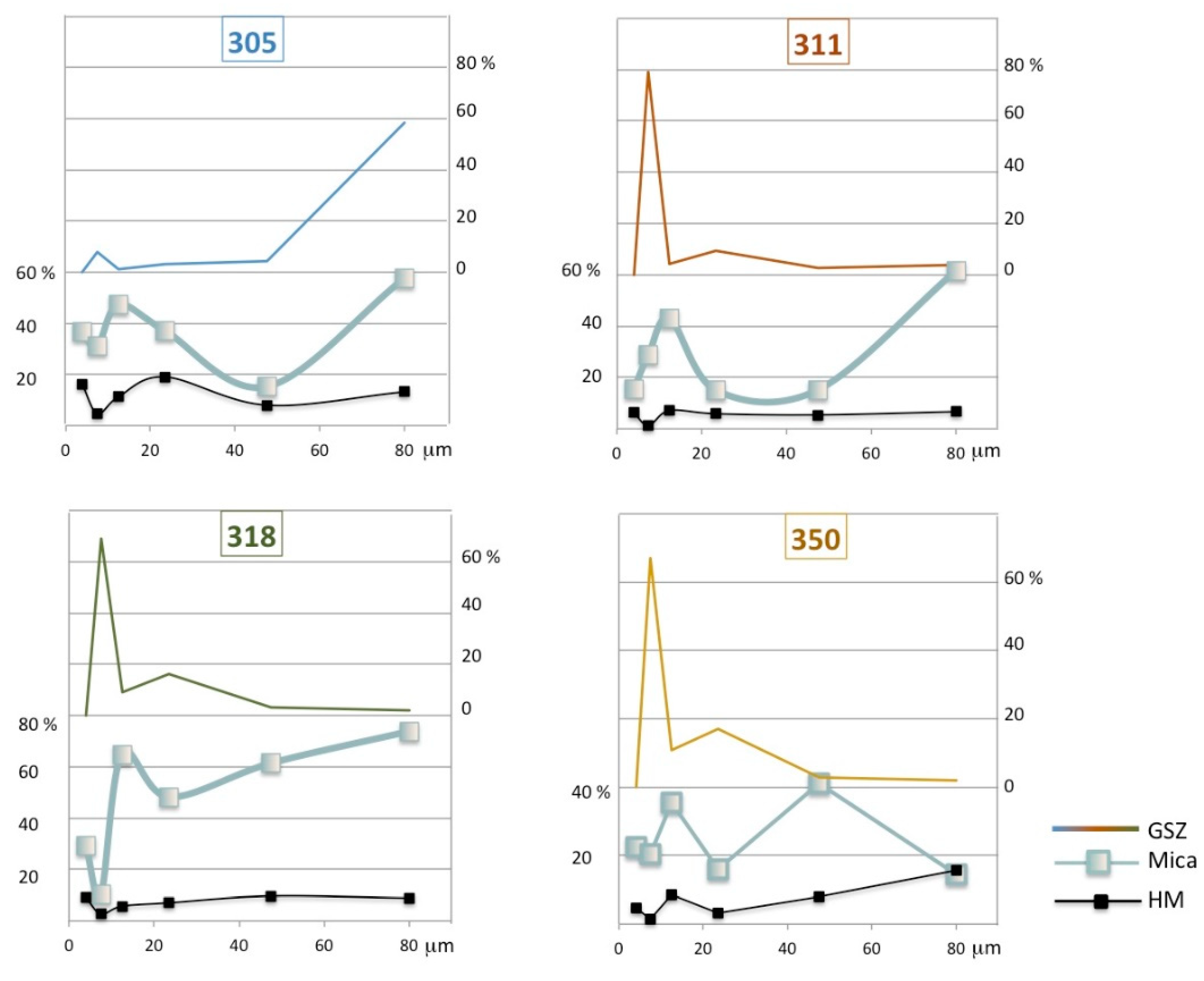
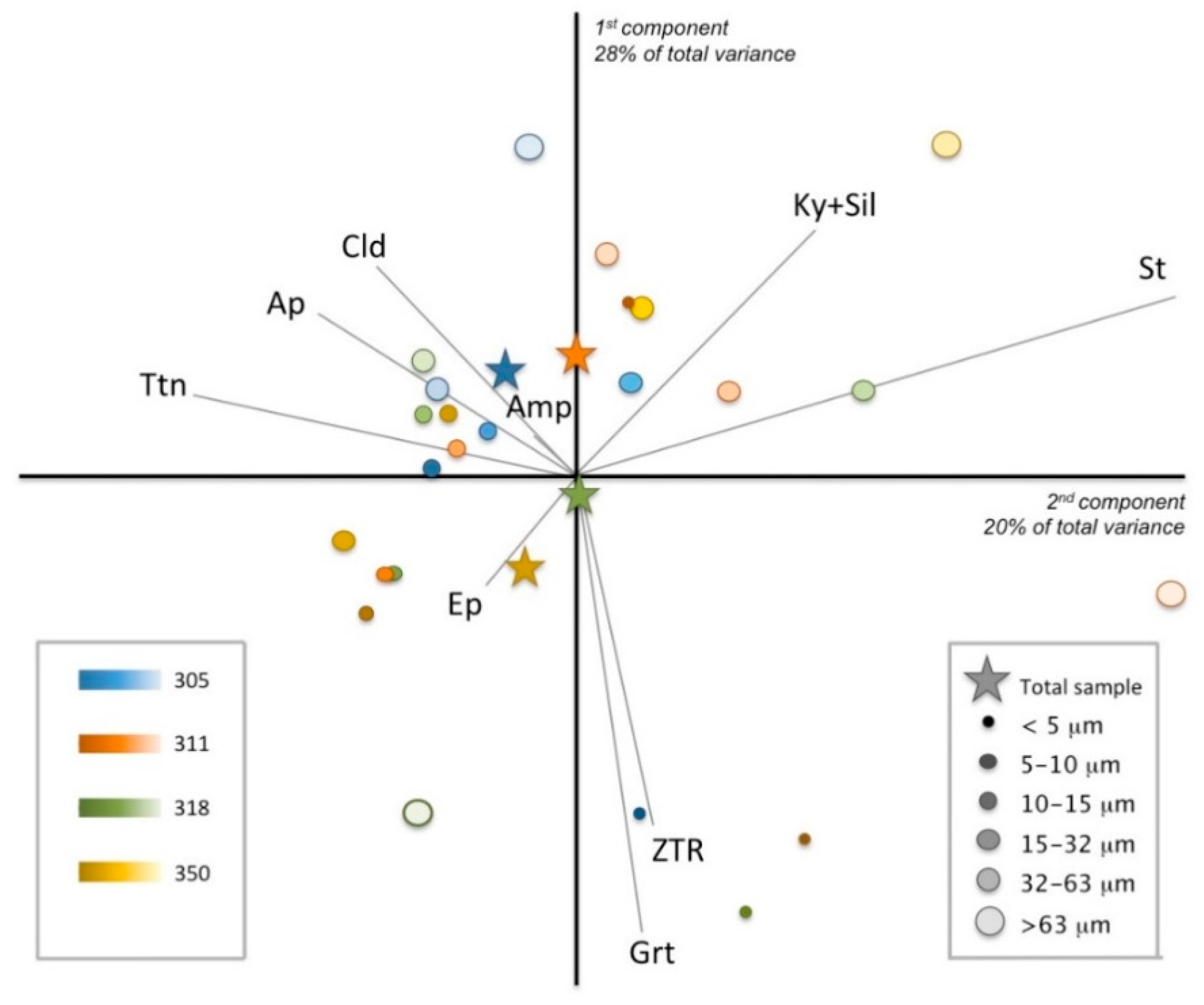


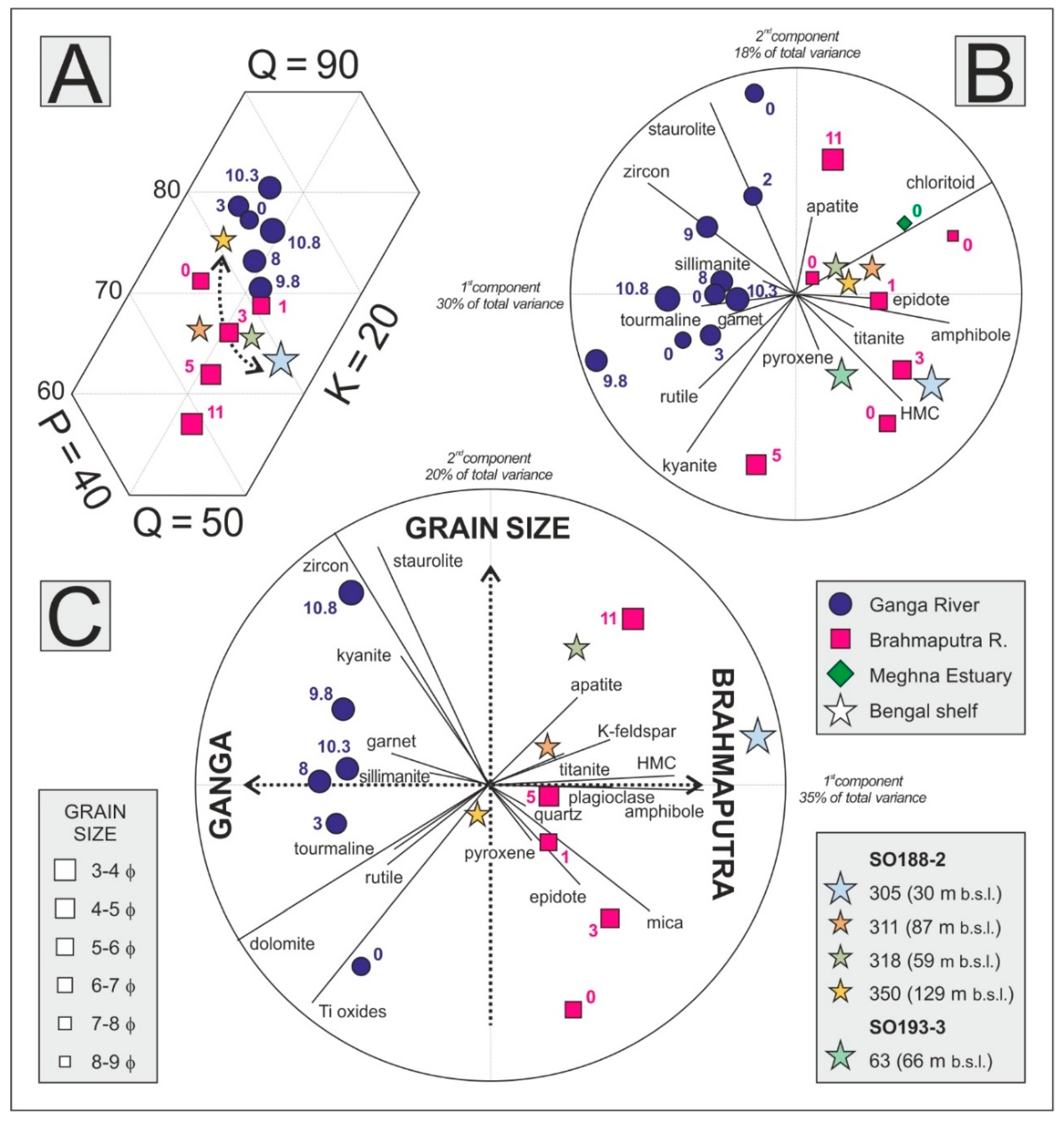
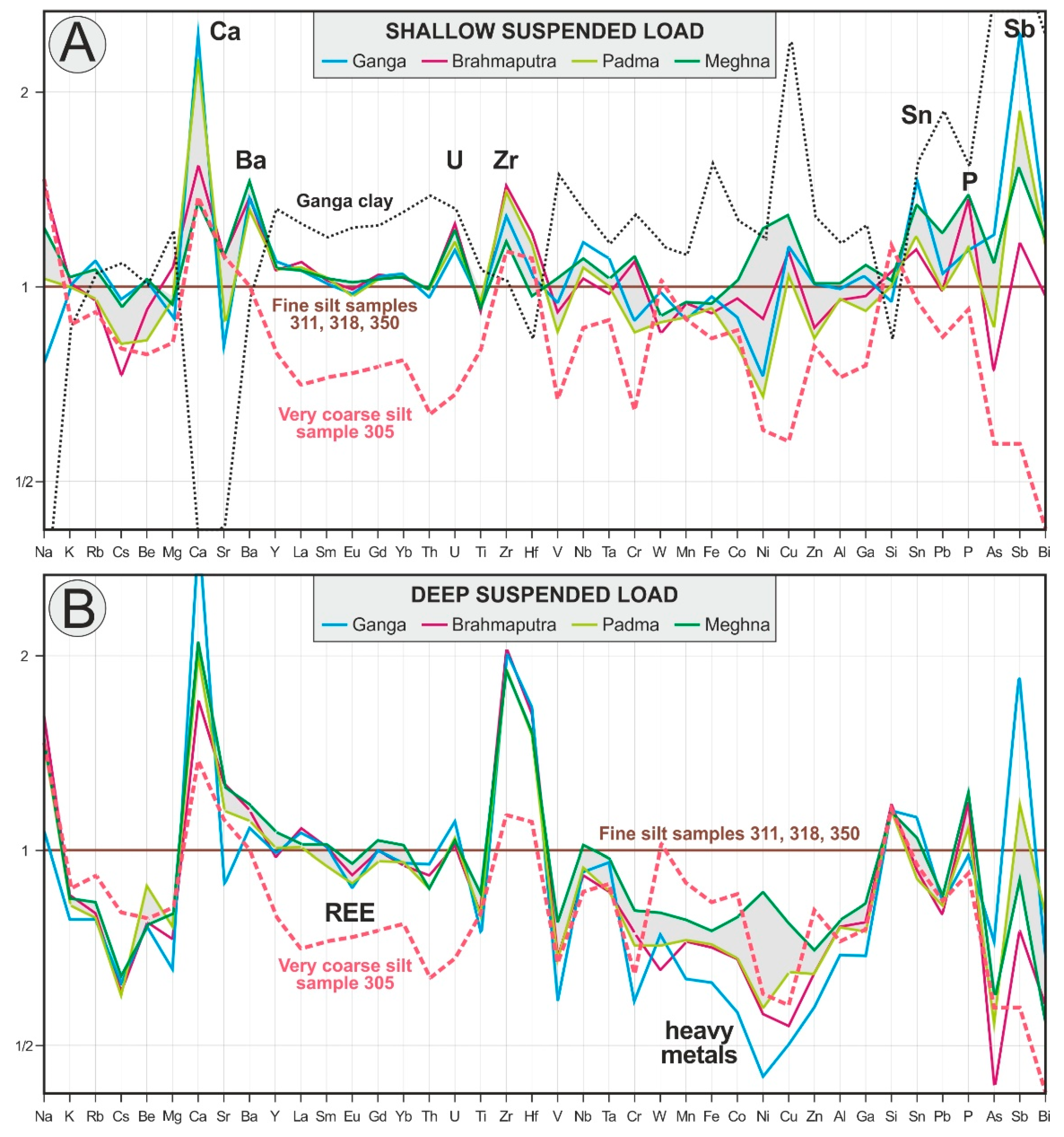
| Sample | GSZ (μm) | Class (wt.%) | Qz | KF | Ab | Ca-Pl | Rf | tHM | Op | Ms | Bt | Chl | Clay | Cc | Do | Alt | OM | & | |
|---|---|---|---|---|---|---|---|---|---|---|---|---|---|---|---|---|---|---|---|
| 305 | <5 | 7.9 | 14 | 1 | 5 | 0 | 9 | 7 | 20 | 0 | 16 | 18 | 7 | 0 | 0 | 0 | 1 | 100.0 | |
| 5–10 | 1.1 | 40 | 4 | 6 | 7 | 0 | 5 | 0 | 15 | 11 | 6 | 0 | 0 | 0 | 6 | 2 | 0 | 100.0 | |
| 10–15 | 3.3 | 20 | 6 | 8 | 1 | 5 | 10 | 1 | 25 | 4 | 19 | 0 | 0 | 1 | 1 | 0 | 0 | 100.0 | |
| 15–32 | 4.3 | 23 | 2 | 5 | 1 | 12 | 19 | 0 | 19 | 0 | 18 | 0 | 0 | 1 | 0 | 0 | 0 | 100.0 | |
| 32–63 | 58.4 | 36 | 9 | 7 | 4 | 20 | 8 | 0 | 7 | 5 | 3 | 0 | 1 | 0 | 0 | 0 | 0 | 100.0 | |
| >63 | 25.0 | 10 | 4 | 5 | 0 | 7 | 12 | 1 | 31 | 10 | 17 | 0 | 0 | 0 | 3 | 0 | 0 | 100.0 | |
| Total sample | 27 | 7 | 6 | 2.9 | 14 | 10 | 0.8 | 15 | 6 | 9 | 1 | 1 | 0.1 | 0.8 | 0.0 | 0.1 | 100.0 | ||
| 311 | <5 | 79.1 | 18 | 2 | 8 | 0 | 6 | 1 | 6 | 0 | 10 | 49 | 1 | 0 | 0 | 0 | 0 | 100.0 | |
| 5–10 | 4.4 | 41 | 5 | 9 | 4 | 0 | 1 | 0 | 19 | 4 | 5 | 0 | 4 | 0 | 4 | 3 | 0 | 100.0 | |
| 10–15 | 9.4 | 29 | 5 | 7 | 3 | 3 | 7 | 0 | 35 | 2 | 6 | 0 | 0 | 1 | 3 | 0 | 0 | 100.0 | |
| 15–32 | 2.6 | 50 | 6 | 10 | 11 | 0 | 6 | 0 | 11 | 1 | 3 | 0 | 0 | 1 | 2 | 0 | 0 | 100.0 | |
| 32–63 | 3.8 | 51 | 10 | 3 | 7 | 0 | 5 | 1 | 9 | 3 | 3 | 0 | 2 | 0 | 2 | 5 | 0 | 100.0 | |
| >63 | 0.7 | 10 | 1 | 1 | 2 | 1 | 7 | 0 | 24 | 16 | 21 | 0 | 9 | 0 | 2 | 6 | 0 | 100.0 | |
| Total sample | 22 | 3 | 6 | 3.0 | 0 | 5 | 0.7 | 10 | 1 | 9 | 39 | 1 | 0.2 | 0.5 | 0.4 | 0.3 | 100.0 | ||
| 318 | <5 | 68.8 | 21 | 2 | 10 | 0 | 9 | 0 | 19 | 0 | 11 | 22 | 1 | 5 | 0 | 0 | 1 | 100.0 | |
| 5–10 | 9.2 | 58 | 3 | 14 | 3 | 0 | 3 | 0 | 9 | 0 | 1 | 0 | 0 | 3 | 3 | 3 | 0 | 100.0 | |
| 10–15 | 16.4 | 16 | 6 | 3 | 0 | 1 | 6 | 0 | 35 | 7 | 23 | 0 | 0 | 0 | 3 | 1 | 0 | 100.0 | |
| 15–32 | 3.4 | 31 | 3 | 9 | 3 | 0 | 7 | 0 | 21 | 19 | 8 | 0 | 0 | 0 | 0 | 0 | 0 | 100.0 | |
| 32–63 | 1.9 | 18 | 5 | 0 | 5 | 0 | 10 | 0 | 33 | 24 | 5 | 0 | 1 | 0 | 1 | 0 | 0 | 100.0 | |
| >63 | 0.4 | 3 | 1 | 1 | 0 | 1 | 8 | 1 | 21 | 48 | 4 | 0 | 7 | 0 | 2 | 1 | 0 | 100.0 | |
| Total sample | 21 | 4 | 5 | 1.5 | 0 | 8 | 0.0 | 26 | 6 | 15 | 8 | 0 | 2.0 | 1.7 | 0.5 | 0.3 | 100.4 | ||
| 350 | <5 | 67.1 | 21 | 2 | 6 | 0 | 4 | 1 | 13 | 0 | 10 | 40 | 2 | 1 | 0 | 0 | 1 | 100.0 | |
| 5–10 | 11.0 | 56 | 3 | 13 | 0 | 0 | 1 | 0 | 12 | 2 | 7 | 0 | 2 | 0 | 1 | 4 | 0 | 100.0 | |
| 10–15 | 16.9 | 40 | 1 | 6 | 1 | 7 | 5 | 3 | 28 | 0 | 7 | 0 | 0 | 0 | 2 | 0 | 0 | 100.0 | |
| 15–32 | 2.9 | 56 | 5 | 10 | 6 | 1 | 3 | 0 | 8 | 6 | 1 | 0 | 0 | 1 | 2 | 0 | 0 | 100.0 | |
| 32–63 | 1.9 | 29 | 4 | 5 | 2 | 7 | 6 | 2 | 21 | 11 | 8 | 0 | 0 | 0 | 5 | 0 | 0 | 100.0 | |
| >63 | 0.2 | 29 | 4 | 1 | 1 | 12 | 11 | 5 | 5 | 2 | 7 | 0 | 10 | 0 | 1 | 13 | 0 | 100.0 | |
| Total sample | 29 | 2 | 7 | 0.4 | 1 | 4 | 1.0 | 15 | 1 | 9 | 27 | 1 | 0.6 | 0.5 | 0.5 | 0.6 | 100.0 | ||
| Sample | GSZ (μm) | Class (%) | tHMC | Zrn | Tur | Rt | TiOx | Ttn | Ap | Ep | Grt | Cld | St | Ky + Sil | Amp | Px | &tHM | |
|---|---|---|---|---|---|---|---|---|---|---|---|---|---|---|---|---|---|---|
| 305 | <5 | 7.9 | 9 | 2 | 0 | 0 | 0 | 3 | 43 | 20 | 0 | 0 | 0 | 30 | 2 | 100 | ||
| 5–10 | 1.1 | 5 | 1 | 1 | 2 | 3 | 3 | 2 | 28 | 4 | 1 | 0 | 0.4 | 50 | 4 | 0 | 100 | |
| 10–15 | 3.3 | 10 | 1 | 5 | 2 | 1 | 3 | 1 | 38 | 4 | 2 | 0 | 4 | 37 | 2 | 2 | 100 | |
| 15–32 | 4.3 | 19 | 1 | 5 | 3 | 0 | 5 | 1 | 31 | 4 | 2 | 1 | 1 | 41 | 4 | 0 | 100 | |
| 32–63 | 58.4 | 8 | 0 | 2 | 1 | 1 | 5 | 2 | 25 | 5 | 2 | 0 | 2 | 52 | 4 | 0 | 100 | |
| >63 | 25.0 | 12 | 0 | 0 | 0 | 0 | 0 | 7 | 7 | 0 | 0 | 0 | 0 | 73 | 13 | 0 | 100 | |
| Total sample | 10 | 0.1 | 2 | 0.7 | 0.3 | 3 | 4 | 20 | 3 | 1 | 0 | 1 | 58 | 7 | 0.1 | 100 | ||
| 311 | <5 | 79.1 | 6 | 4 | 0 | 0 | 0 | 6 | 0 | 0 | 0 | 0 | 0 | 90 | 0 | 100 | ||
| 5–10 | 4.4 | 1 | 0 | 1 | 2 | 1 | 2 | 1 | 30 | 4 | 1 | 0 | 0 | 56 | 2 | 0 | 100 | |
| 10–15 | 9.4 | 7 | 1 | 2 | 2 | 1 | 5 | 1 | 32 | 4 | 1 | 0 | 2 | 47 | 2 | 1 | 100 | |
| 15–32 | 2.6 | 6 | 0 | 2 | 0 | 0 | 4 | 0 | 28 | 5 | 4 | 1 | 2 | 49 | 7 | 0 | 100 | |
| 32–63 | 3.8 | 5 | 1 | 1 | 1 | 0 | 3 | 3 | 28 | 2 | 3 | 1 | 1 | 51 | 7 | 0 | 100 | |
| >63 | 0.7 | 7 | 4 | 6 | 4 | 0 | 0 | 0 | 33 | 6 | 0 | 6 | 4 | 39 | 0 | 0 | 100 | |
| Total sample | 5 | 0.9 | 2 | 1 | 0.4 | 4 | 1 | 31 | 4 | 2 | 0.4 | 1 | 48 | 3 | 1 | 100 | ||
| 318 | <5 | 68.8 | 9 | 0 | 0 | 13 | 0 | 0 | 41 | 9 | 0 | 0 | 0 | 37 | 0 | 100 | ||
| 5–10 | 9.2 | 3 | 1 | 2 | 1 | 0 | 3 | 1 | 21 | 3 | 1 | 0 | 0 | 62 | 4 | 0 | 100 | |
| 10–15 | 16.4 | 6 | 1 | 2 | 2 | 1 | 5 | 3 | 20 | 5 | 2 | 0 | 1 | 61 | 0 | 1 | 100 | |
| 15–32 | 3.4 | 7 | 1 | 1 | 0 | 0 | 0 | 1 | 27 | 3 | 1 | 1 | 1 | 62 | 4 | 0 | 100 | |
| 32–63 | 1.9 | 10 | 1 | 1 | 0 | 0 | 3 | 2 | 24 | 2 | 3 | 0 | 1 | 57 | 7 | 1 | 100 | |
| >63 | 0.4 | 8 | 7 | 7 | 0 | 0 | 10 | 3 | 13 | 43 | 0 | 0 | 0 | 13 | 3 | 0 | 100 | |
| Total sample | 8 | 0.7 | 2 | 1 | 0.3 | 4 | 2 | 21 | 4 | 1 | 0.1 | 1 | 60 | 2 | 1 | 100 | ||
| 350 | <5 | 67.1 | 4 | 0 | 0 | 14 | 0 | 0 | 0 | 23 | 0 | 0 | 0 | 55 | 8 | 100 | ||
| 5–10 | 11.0 | 1 | 4 | 6 | 3 | 1 | 3 | 1 | 34 | 5 | 2 | 0 | 0 | 33 | 6 | 1 | 100 | |
| 10–15 | 16.9 | 5 | 2 | 4 | 2 | 3 | 3 | 2 | 29 | 4 | 4 | 0 | 2 | 45 | 1 | 1 | 100 | |
| 15–32 | 2.9 | 3 | 1 | 3 | 3 | 0 | 3 | 2 | 34 | 4 | 7 | 0 | 0 | 45 | 1 | 0 | 100 | |
| 32–63 | 1.9 | 6 | 0 | 2 | 1 | 0 | 5 | 1 | 37 | 3 | 4 | 1 | 2 | 46 | 2 | 0 | 100 | |
| >63 | 0.2 | 11 | n.d. | n.d. | n.d. | n.d. | n.d. | n.d. | n.d. | n.d. | n.d. | tr. | n.d. | n.d. | n.d. | n.d. | ||
| Total sample | 4 | 2 | 4 | 2 | 2 | 3 | 2 | 31 | 4 | 4 | 0 | 2 | 44 | 1 | 1 | 100 | ||
© 2019 by the authors. Licensee MDPI, Basel, Switzerland. This article is an open access article distributed under the terms and conditions of the Creative Commons Attribution (CC BY) license (http://creativecommons.org/licenses/by/4.0/).
Share and Cite
Borromeo, L.; Andò, S.; France-Lanord, C.; Coletti, G.; Hahn, A.; Garzanti, E. Provenance of Bengal Shelf Sediments: 1. Mineralogy and Geochemistry of Silt. Minerals 2019, 9, 640. https://doi.org/10.3390/min9100640
Borromeo L, Andò S, France-Lanord C, Coletti G, Hahn A, Garzanti E. Provenance of Bengal Shelf Sediments: 1. Mineralogy and Geochemistry of Silt. Minerals. 2019; 9(10):640. https://doi.org/10.3390/min9100640
Chicago/Turabian StyleBorromeo, Laura, Sergio Andò, Christian France-Lanord, Giovanni Coletti, Annette Hahn, and Eduardo Garzanti. 2019. "Provenance of Bengal Shelf Sediments: 1. Mineralogy and Geochemistry of Silt" Minerals 9, no. 10: 640. https://doi.org/10.3390/min9100640





